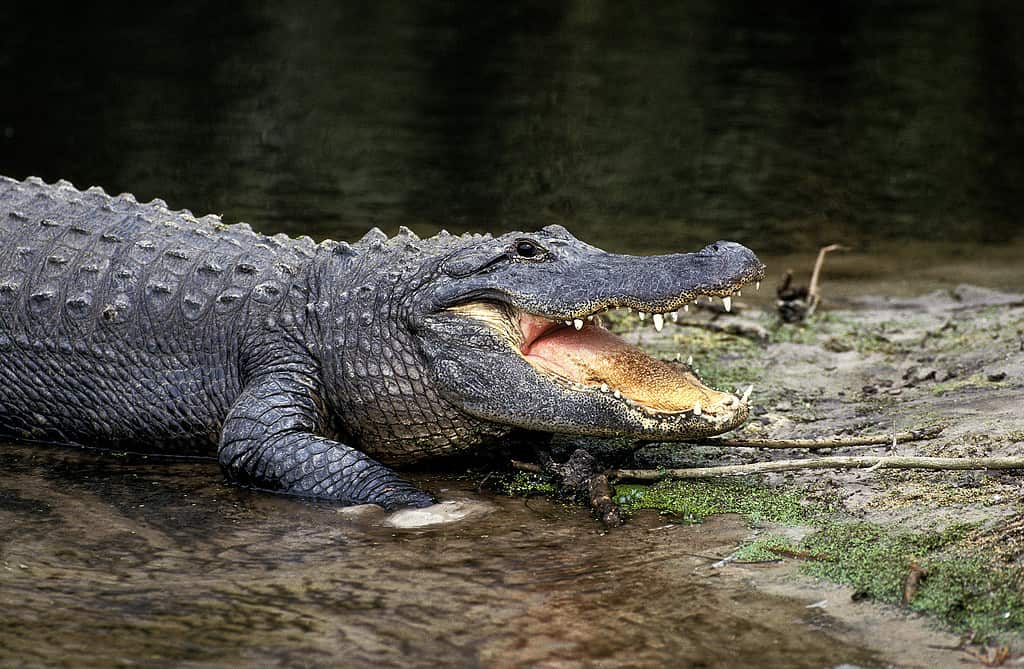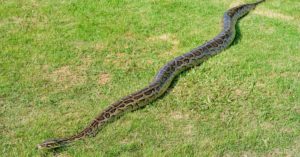Let’s be honest, alligators can be divisive creatures. While some people find themselves scared of these gigantic reptiles, others think they’re fascinating. However you feel, one thing is for certain: these animals are widespread throughout the United States. In fact, in many places, alligators live in close proximity to humans. One of these places is in Wilmington, North Carolina. Whether you’re a year-round resident or just someone planning to visit this area in the future, you might have questions about where alligators can be found in this city. Let’s answer this question and explore alligator safety tips that you can use if you find yourself face-to-face with one!
Alligators in Wilmington, NC: a Brief Overview

In the wild, alligators typically live to be between 30 and 50 years old.
©TimVickers, Public domain, via Wikimedia Commons – License
Alligators are common residents all throughout the state of North Carolina. They have been spotted in just about every place you can imagine. However, they prefer to stick close to bodies of water such as lakes, rivers, marshes, and ponds. Although they prefer these locations, that doesn’t mean that they don’t wander off into urban areas ever so often. According to CBS17 News, back in 2019, an alligator wandered onto the road and stopped traffic for a while before retreating to the water. Residents aren’t perturbed by the presence of these gators at all. In fact, many individuals living in Wilmington think of them as a part of the community.
Where to Find Alligators in Wilmington

Wilmington, North Carolina is home to roughly 120,000 individuals.
©ChrisBoswell/iStock via Getty Images
Alligators are all over Wilmington, but certain locations are home to a higher density of these animals than others. Here are some places where alligator sightings have been confirmed throughout this city.
- Alligator Creek – As its name suggests, this location is somewhat of an alligator hotspot in North Carolina. The freshwater areas are typically safe to swim. Instead, alligators inhabit the saltwater creek.
- Masonboro Island – Compared to other places in Wilmington, it might be more difficult to catch a glimpse of an alligator at Masonboro Island. Despite this, sightings are still reported here. Back in 2022, a man was lucky enough to take a video of one on the beach before it swam away. However, this was somewhat of a rare occurrence, and those visiting this area likely won’t have to deal with alligators during their trip.
- Greenfield Lake – This location just might be the best place to go alligator watching throughout all of Wilmington. In addition to the alligator population, this lake is home to a wealth of local wildlife.
- Bradley Creek – The alligator that we discussed earlier who stopped traffic on a roadway likely came from Bradley Creek, which was somewhat close to the scene of the incident.
- Orton Pond – Although Otron Pond is technically located in nearby Brunswick, we had to give it an honorable mention. Seeing alligators here is commonplace, and visitors have a great chance to observe them in their natural habitat.
Other Places in North Carolina to See Alligators

Alligators are a common sight along Cape Fear river.
©Paul Brady Photography/Shutterstock.com
Although Wilmington is home to many different alligator-watching locations, there are many outside of this city worth visiting as well. For example, Lake Waccamaw State Park can be a wonderful location to safely observe alligators from a distance. Cape Fear is another popular alligator hotspot as well, and visitors report that many can be found surrounding the battleship on site.
According to the North Carolina Wildlife Resources Commission, “The American alligator ranges from coastal North Carolina to southern Florida west to central Texas. In North Carolina, they inhabit freshwater areas mostly east of Robeson County northward to Gates County. The largest populations live in the coastal counties of Brunswick, New Hanover, Craven, Onslow, and Pender”
Alligator Safety Tips

American alligators have a bite force of 2000 pounds per square inch.
©slowmotiongli/iStock via Getty Images
Luckily, alligator attacks are rare in North Carolina. Despite this, it’s always a good idea to educate yourself on safety tips to use during the event of an emergency. Before attacking, alligators will likely hiss as a warning sign. If you observe this behavior, back up immediately to prevent provoking them further. These animals can run at speeds of roughly 10 miles per hour. However, they are unable to maintain it for a long period of time. If you find yourself being aggressively pursued by an alligator, do your best to run as far as you can, as fast as you can. Making loud noises along the way may also help to deter them.
If you find yourself bit or captured by an alligator, fight back as hard as possible. Kick, punch, poke their eyes, and use any tools around you to free yourself from their grasp. Alligators are smart, and they will likely let you go if they feel as though you are too difficult to overwhelm. Never feed alligators or entice them with food. It is important to note that both humans and pets should avoid swimming in bodies of water that alligators are known to frequent. Although alligator attacks are uncommon, the risk of one is always present. Keeping a distance of roughly 20 to 30 feet will help ensure that you are able to safely observe these reptiles.
Final Thoughts
Alligators are a part of life for people living in Wilmington, and many people appreciate their company. They can be fascinating to observe, and they play a key role in the local ecosystem. As long as you practice proper safety when you find yourself in close proximity to these animals, chances are you’ll be just fine.
The photo featured at the top of this post is © Wirestock Creators/Shutterstock.com
Thank you for reading! Have some feedback for us? Contact the AZ Animals editorial team.







